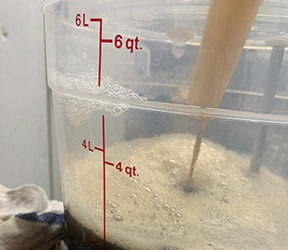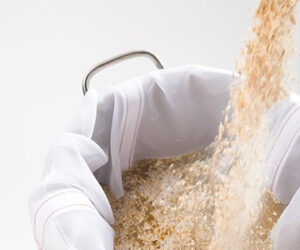Bulk Up Your Sparge Technique
Your mash is mashed and conversion is complete. It’s time to sparge. If you sparge by traditional methods, it’s a real balancing act. In your efforts to rinse the mashed grains, you have to sprinkle water on top of the grain bed at the exact rate you draw off the wort from the bottom.
It’s not always as simple as it sounds. It is difficult to get the balance just right for more than a minute or two. If you let it go for too long, the bed will get too dry or the sparge water will start filling up the mash tun, threatening to overflow onto the floor. And in the meantime the sparge water, which should be kept at 170° F, cools to a lower, less effective temperature.
There’s got to be a better way, right? You guessed right. Hey, if there were no better way, this article would pretty much have come to a grinding halt right here.
It’s called batch sparging. Although it takes the same amount of total time to complete the sparge with the batch method and the trickle method, batch sparging needs a heck of a lot less maintenance. In other words you can do other stuff, such as clean up the mash gear and get ready for brewing, have a beer, watch the game, whatever, instead of hovering over the lauter tun like an obsessed mother hen.
A Quick Review
Sparging is the process of rinsing extract out of barley malt that has been mashed. During the mash crushed malt is steeped in hot water over time. Slowly nature’s magic activates on-board enzymes to convert starches to fermentable sugar.
You need only a little bit of water to mash, usually around a quart per pound of grain. To get six gallons of wort from, say, six pounds of grain, you have to rinse the grains with hot water, collecting it as you go. That’s sparging.
Conventional wisdom states that you have to draw out the wort from the bottom as you sprinkle or slowly pour hot water into the top of the lauter tun — that’s the vessel, usually a picnic cooler or plastic bucket, with the false bottom used to separate the grain from the wort. That’s where the water-in, wort-out balancing act takes effect.
This procedure was inspired by big, high-volume brewers. When you are producing millions of gallons of wort, you want to build the lauter tun just big enough to comfortably hold the whole mash. In that case, sprinking is the only way to go.
But at home your mash/lauter tun is probably plenty big enough to hold your mash, plus most of your total sparge water. Why not save a step and add sparge water in quantity, instead of trickling it in a drop at a time?
If you think that makes sense, there might be some batch sparging in your future.
The Batch-Sparge Option
Mary Samuels, a homebrewer near Olympia, Wash., has been batch sparging for some time now and has successfully converted quite a few brewers to the technique.
“I prefer the method because of its simplicity. It eliminates the necessity to balance inflow with outflow. Plus, there may be a slight increase in yield, because resettling of the grain bed eliminates the effect of channeling that occurs when the grain bed is poorly settled,” Samuels says.
“Channeling” occurs when sparge water seeks the path of least resistance in the grain bed, carving a channel through the grains. This reduces efficiency since that channeled water does not pick up as much extract on its way through the bed.
The method Samuels recommends for homebrewers is to drain off (into your brewpot) the first runnings after the mash is done and conversion is complete. Then add half your total sparge water at 170° F, stir the grain bed again, recirculate until clear, and drain into your brewpot. Add the remaining hot water and drain without stirring the mash.
As with other sparge techniques, you do not want to drain the grain bed too quickly. You need to allow the sparge water to do its work. Drain slowly.
“An additional advantage to batch sparging is that the sparge water is at the correct temperature when it is added to the mash and you do not have to worry about significant temperature drop,” she says.
Why not add all the sparge water at one time, instead of splitting it into two additions? The reason is that after conversion, the mash contains two kinds of extract — that which is floating around as liquid surrounding the grain and that which is trapped inside the grains. If your sparge system can handle it and is not prone to stuck runoff, you should drain the grain bed nearly dry on the first go. Then, in theory, the sparge water will rinse out the secondary extract from the malt grains.
This method is not limited to homebrewing. Some small-volume professional breweries also sparge this way, including Sudwerk Privatbrauerei Hubsch in Davis, Calif.
Dave Sipes, Sudwerk’s brewmaster, explains that batch sparging is necessary because of the design of the brewpub’s 15-barrel system. “We have no hot liquor tank, just a temporary wort receiver. Our mash tun doubles as the kettle. So we pump the mash to the lauter tun, clean the kettle/mash tun and use it to heat the sparge water while we drain the first runnings. The sparge water is added in two additions while slowly raking the mash bed. As soon as the sparge is done, we pump the wort back into the kettle to start the brew.
“The sparge water sort of chases the wort around the system. By batch sparging we keep the hot wort from sitting around too long, which would encourage formation of DMS and other unwanted compounds,” Sipes says. By DMS, Sipes means dimethyl sulfide, which gives beer a ‘cooked corn’ off-flavor, which is almost always undesireable in any style.
Sipes also oversees production in Sudwerk’s 65-barrel micro system, which uses the traditional spray-sparge method. “I have not noticed any significant difference in wort quality. We have not done a formal study, but anecdotally speaking, batch sparging and spray sparging are equally effective at Sudwerk,” Sipes says.
Homebrewer John Huegel, Erie, Pa., also regularly batch sparges. “It’s simple. It lets me get started with the sparge quickly without worrying about flow rate and temperature. I do trickle sparge on occasion, but I do not have any sparge device. I just manually trickle the sparge water in. But the batch method is a lot easier,” he says.
Huegel reminds brewers to dechlorinate sparge water, if you are using chlorinated tap water. This can be achieved by letting the water sit out overnight.
Huegel says his yield is about the same for each method. “I do not get tremendous yield either way, but it’s the same at around 25 points per pound per gallon. I attribute this to my mill, a motor-driven Corona. I have noticed, on occasion, pockets of sweet, unsparged grain when I use the trickle method. This does not happen when batch sparging because the grain bed is stirred during the sparge process,” Huegel says.
Maryland homebrewer Michael Daleiden is also a batch sparger. “It’s so easy. With a good cooler for mashing, temperature variance is minimal. Batch sparging keeps me from worrying about maintaining the ‘trickle’ or maintaining temperature of the sparge water. I use the method for all my grain-brewing adventures,” he says.
Sounds like batch sparging is preventing a fair amount of worrying out there. And if you are a partial-mash afficionado, batch sparging works just as well there, too.
Batch sparging works in any lauter system, as long as the system is not prone to stuck runoffs. If you are having that problem, you should consider a better lauter tun, anyway. Get a manufactured false bottom or use a slotted manifold or screen-type lauter system. The homemade “Zapap” double-bucket system probably has the most potential for trouble when you drain the grain bed nearly dry. Give batch sparging a try. By making sparging less of a chore, it makes your brewing sessions even more relaxing.


